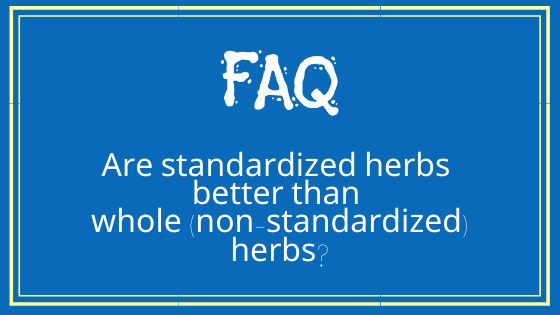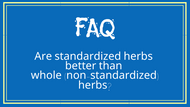FAQ- Standardized Herbs
Posted by TriLight Health on Nov 25th 2020

Q: Are standardized herbs better than whole (non-standardized) herbs?
A:There is no yes or no answer, and even herbalists are split on this subject. Standardization means that the active ingredient or what's believed to make the herb effective, is extracted from the whole herb, measured and sometimes concentrated, then packaged. According to well-known health expert Dr. Andrew Weil, this is a guarantee that the product contains what it's supposed to contain in amounts sufficient to produce a desired effect. Sometimes the standard is lower than you would receive through a whole herb extract!
On the other side of the issue, the facts are:
(1) Whole herbs have been used effectively & safely for thousands of years.
(2) Herbs contain dozens of constituents (which have not been identified), with many beneficial properties that work synergistically with each other. This is why single herbs are effective for a variety of conditions.
(3) Scientists still do not fully understand the complex interrelationships of all the components found within whole herbs.
Here is another look at this issue:
Whole Herbs Vs. Standardized Herbal Extracts: Which Is Better?
By Amy Kosowski, M.S., LNC, May 3, 2004
The mainstream use of herbal medicines is becoming increasingly popular, and there are many herbal products to choose from. With so many choices, it is easy to get confused about which forms of herbs are right for you. One important decision is whether to use whole herbs or standardized herbal extracts. This can be tricky, because even the experts are split on this issue. Therefore, it is best to know the facts about the difference between the two so that you can make an informed decision.
A whole herb is just what it says: the whole herb, usually dried and encapsulated or processed in preserved in alcohol or other solvent. Whole herbs contain all of the constituents of the plant and have been used for hundreds of years by many cultures. In fact, modern medicine originated with the use of whole herbs. The medicinal properties of herbs have been learned through empirical observation and the information has been passed down through successive generations of healers. Although the effects of herbs have not always been formally and scientifically researched, whole herbs have long track record validating their safety and efficacy. The chemical makeup of an herb can vary slightly, however, depending on a variety of factors. First, the environment in which the plant has been grown has an effect on the constituents of the herb. The time of year it is harvested, the soil in which it is grown, and the weather all influence the overall quality of the final product. Second, methodology plays a role. For example, the age of the plant at harvest, the exact part of the plant being used, and processing techniques can all make a difference. Finally, each plant or population of plants has its own individual genetics, thus adding another source of end product variation. A standardized herbal extract is an herb extract with one or more components present in a given amount, usually expressed as a percentage. The intention behind the standardization of herbs is to guarantee that the consumer is getting a product in which the chemistry is consistent and comparable to other similar products. This practice has developed out of the drug model of herbal medicine, where modern scientists have attempted to identify the components of a plant that have definite pharmacological activity in the body. Unfortunately however, while scientists can isolate many constituents from an herb and discover how particular chemicals may act in the body, they inadvertently remove or overlook components that may contribute to the activity of the whole herb. Consequently, standardization concentrates one constituent at the expense of other potentially important ones, while changing the natural balance of the herb’s components. Standardization, therefore, is based on the idea that isolated compounds are responsible for the action of an herb. Almost no medicinal herbs, however, are known for just a single function. In fact, plants contain a complex blend of phytochemicals and as naturally concentrated foods, have the unique ability to address a multiplicity of problems simultaneously. The full medicinal value of herbs is most likely due to their internal complexity and to the interactions of the different components within the body rather than to one of its specific components. Furthermore, many of the constituents within an herb are as yet unknown, and internal chemical interactions within and among herbs are even less understood. Therefore, it is doubtful that a standardized herbal extract can exhibit the same spectrum of use as the whole herb.





